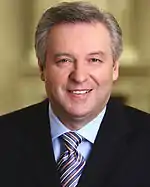Hermann Schützenhöfer
Hermann Schützenhöfer (pronounced [ˈhɛʁman ˈʃʏtsn̩ˌhøːfɐ]; born February 29, 1952 in Edlitz, Lower Austria) is governor of the Austrian province Styria and chairman of the Styrian People's Party (STVP/ÖVP) since 2006.
Hermann Schützenhöfer | |
|---|---|
 | |
| Governor of Styria | |
| Assumed office June 16, 2015 | |
| Chancellor | Werner Faymann Christian Kern Sebastian Kurz Brigitte Bierlein Sebastian Kurz |
| Deputy | Anton Lang |
| Preceded by | Franz Voves |
| Personal details | |
| Born | 29 February 1952 Edlitz, Austria |
| Political party | ÖVP (Austrian People's Party) |
Life
Schützenhöfer grew up in Edlitz in Lower Austria. In 1966, Schützenhöfer's family moved back to Kirchbach in Styria, where Schützenhöfer completed compulsory school with the polytechnical year. He became an apprentice in a grocery store and wrote articles as a local journalist for the Kleine Zeitung, the Sonntagspost and the Styrian youth magazine Horizont (= "Horizon" - an media organ of the Junge Volkspartei). Schützenhöfer then entered politics in 1970 and became director of the Styrian Young People's Party (JVP) and in 1976 chairman of JVP Styria. In 1978 he acted as director of the ÖAAB (= Workers Union of the People's Party) in Styria. In 2006 he succeeded former governor Waltraud Klasnic as party leader and acted as vice governor. After the Styrian State elections in 2010, Hermann Schützenhöfer and governor Franz Voves of the SPÖ formed the as called "reform partnership coalition" (Reformpartnerschaft). Schützenhöfer again took over the office of the First Deputy Governor in October. There he was also responsible for the areas of personnel agendas, mayors, tourism, folk culture, provincial- and community development.[1] In June 2015 when Schützenhöfer finally became Styrian governor – even though the STVP again had fallen behind the Socialist Party SPÖ.[2] On Nov. 24th 2019 the People's Party won the Styrian elections with 36,05% - a month later Schützenhöfer again formed a coalition with the SPÖ.
Political activities
Schützenhöfers most ambitious project was to reshape the structure administration within Styria ("Gemeindestrukturreform") which significantly reduced the numbers of communities and districts. This reform gained much approval but also set off a major controversy.[3][4] He played a significant role in the process of renewing the Austrian People's Party which also lead to the party leadership of Sebastian Kurz.[5]
References
- "Landesregierung: SPÖ und ÖVP einigten sich". May 23, 2020.
- "The State of Styria, entry to Hermann Schützenhöfer". October 18, 2018.
- "Das Land Steiermark - Gemeindestrukturreform". October 19, 2018.
- "Schützenhöfer - Einige in Wien hoffen, dass wir auf die Nase fallen". Der Standard. March 10, 2015.
- "Alle werden sich bemühen, dass Kurz übernimmt". Die Presse. May 10, 2017.